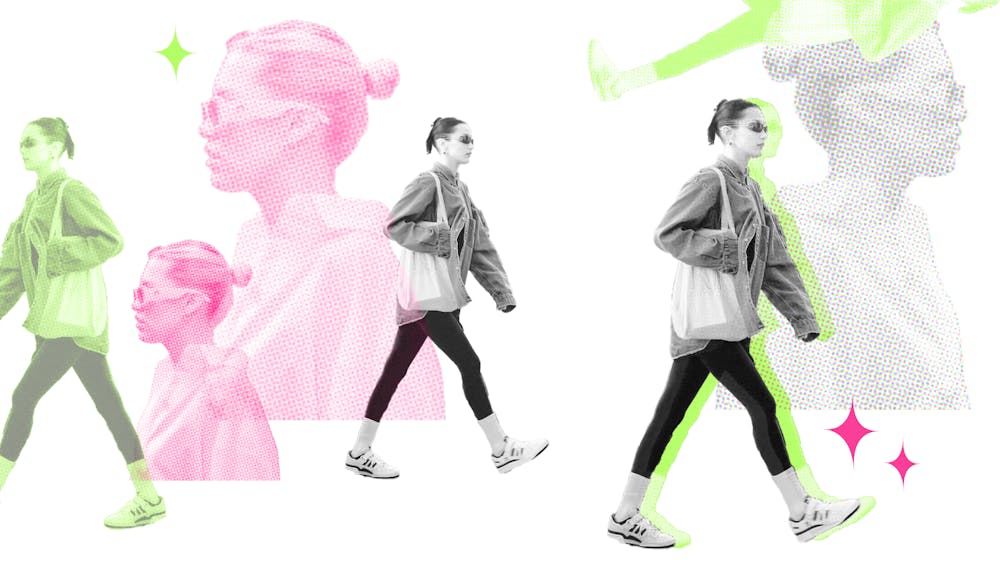Social media has ushered in the era of microtrends, where online hypervisibility attributes to the success of certain styles in the market (i.e. these trends tend to leave just as quickly as they peak). The “clean girl aesthetic,” social media’s most recent fascination, has stormed the beauty world and occupied our online feeds. Paired well with the Scandinavian streetwear style, this new trend has been largely accredited with beauty leaders like Matilda Djerf, Bella Hadid, and Hailey Bieber—it’s all about the slicked–back hair, gold hoops, clear lip gloss, and minimal makeup look. No one really knows how long this trend is planning to stick around, but it doesn’t look like it’s going anywhere anytime soon.
Microtrends like the clean girl aesthetic are often rooted in consumerism—where every person feels the necessity to buy popular new products, succumbing to marketing tactics. But the primary backlash this trend is receiving has stemmed from its lack of representation, as it mainly spotlights thin, white women who have become the face of this trend. Furthermore, the cost of chasing microtrends is only accessible to those who can afford to switch out all their newly minted products at frequencies relative to the rise and fall of microtrends.
Let it be clear, there’s no harm in enjoying this type of look for yourself. It’s convenient and has an effortless aura to it. Yet, it’s imperative to acknowledge how women of color have been mislabeled and wrongly judged on their abilities to pull off this look, which is paradoxical to the contemporary perception and marketing of this style.
The truth of the matter is that the slicked–back hair look with gold hoops in all of its glory originated from Black and brown communities decades ago. While a few years ago, women of color would be mocked for oiling back their hair with natural ingredients, being called “greasy,” the clean girl aesthetic has come to incorporate that exact practice. Only this time, beauty influencers are using highly marketed products, like the much–raved–about Olaplex bonding oil or TIGI Bed Head wax stick. In the past, women who donned these hairstyles or makeup looks used to be referred to as “ghetto” or unclean. It’s evident that societal beauty expectations strongly revolve around the standards that have developed from Western styles, where white– and European–focused looks are admired and boosted, regardless of whether they were originally influenced (or extracted) from communities of color.
Social media users have become accustomed to discussing the pattern of Black and brown beauty practices being co–opted at the hands of microtrend cycles. Over the decades, in and out of their workplaces, several women of color have reported feeling judged for their hoops and slicked–back hairstyles, catching unwanted attention and side eyes. Recently, these similar looks have been relabeled as appropriate, or rather the new “clean” norm.
People of color are perpetually sidelined when it comes to the world of fashion and beauty. Seeing the influx of Western standards redefining these customs and slightly tweaking them to fit European standards raises concern. It erases the original communities that were the blueprint for the clean girl aesthetic in the first place. When creators speak out about issues like these, several comments tend to dismiss why these conversations are actually happening, or overlook how it can be an issue of appropriation.
These trends are frustrating reminders of how trends do not pay homage to the roots of these aesthetics or to the BIPOC women who have been looked down upon because of them in the past. Fads like the clean girl aesthetic were originally judged and scorned before they were gentrified and considered the new fashion. For many BIPOC women, the gold hoops, minimal makeup, and slicked hair even go so far as to be a symbol of their culture. The backlash, or rather request for recognition, is rightful as affected communities speak up about what customs of theirs are continually stolen and used as a trendy aesthetic, allowing influencers to claim ideas and hugely profit from them in a consumerist world.







